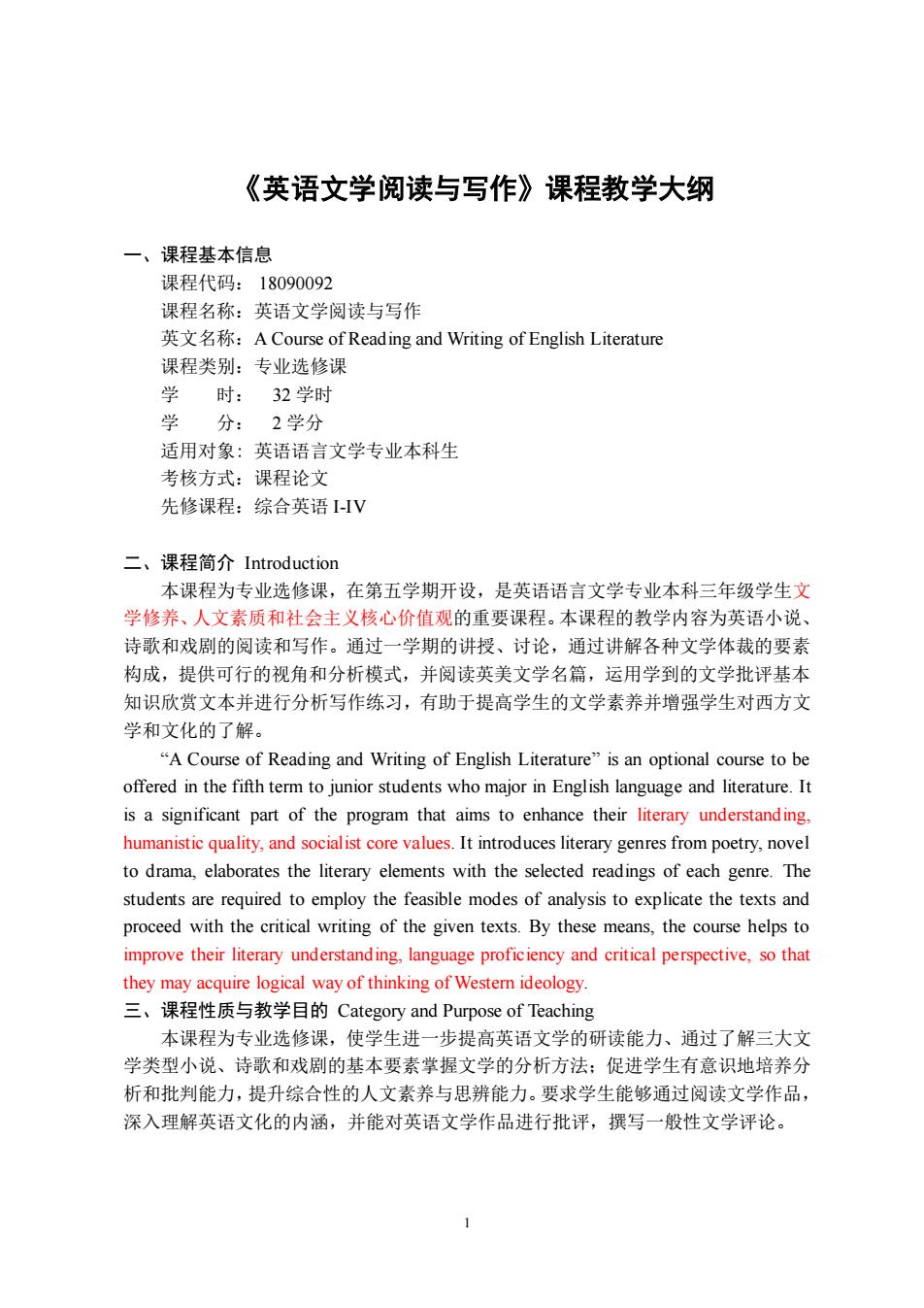
《英语文学阅读与写作》课程教学大纲 一、课程基本信息 课程代码:18090092 课程名称:英语文学阅读与写作 英文名称:A Course of Reading and Writing of English Literature 课程类别:专业选修课 学 时: 32学时 学 分:2学分 适用对象:英语语言文学专业本科生 考核方式:课程论文 先修课程:综合英语HV 二、课程简介Introduction 本课程为专业选修课,在第五学期开设,是英语语言文学专业本科三年级学生文 学修养、人文素质和社会主义核心价值观的重要课程。本课程的教学内容为英语小说 诗歌和戏剧的阅读和写作。通过一学期的讲授、讨论,通过讲解各种文学体裁的要素 构成,提供可行的视角和分析模式,并阅读英美文学名篇,运用学到的文学批评基本 知识欣赏文本并进行分析写作练习,有助于提高学生的文学素养并增强学生对西方文 学和文化的了解。 "A Course of Reading and Writing of English Literature"is an optional course to be offered in the fifth term to junior students who major in English language and literature.It is a significant part of the program that aims to enhance their literary understanding. humanistic quality,and socialist core values.It introduces literary genres from poetry,novel to drama,elaborates the literary elements with the selected readings of each genre.The students are required to employ the feasible modes of analysis to explicate the texts and proceed with the critical writing of the given texts.By these means,the course helps to improve their literary understanding.language proficiency and critical perspective,so that they may acquire logical way of thinking of Westem ideology 三、课程性质与教学目的Category and Purpose of Teaching 本课程为专业选修课,使学生进一步提高英语文学的研读能力、通过了解三大文 学类型小说、诗歌和戏剧的基本要素掌握文学的分析方法:促进学生有意识地培养分 析和批判能力,提升综合性的人文素养与思辨能力。要求学生能够通过阅读文学作品 深入理解英语文化的内涵,并能对英语文学作品进行批评,撰写一般性文学评论。 1
1 《英语文学阅读与写作》课程教学大纲 一、课程基本信息 课程代码: 18090092 课程名称:英语文学阅读与写作 英文名称:A Course of Reading and Writing of English Literature 课程类别:专业选修课 学 时: 32 学时 学 分: 2 学分 适用对象: 英语语言文学专业本科生 考核方式:课程论文 先修课程:综合英语 I-IV 二、课程简介 Introduction 本课程为专业选修课,在第五学期开设,是英语语言文学专业本科三年级学生文 学修养、人文素质和社会主义核心价值观的重要课程。本课程的教学内容为英语小说、 诗歌和戏剧的阅读和写作。通过一学期的讲授、讨论,通过讲解各种文学体裁的要素 构成,提供可行的视角和分析模式,并阅读英美文学名篇,运用学到的文学批评基本 知识欣赏文本并进行分析写作练习,有助于提高学生的文学素养并增强学生对西方文 学和文化的了解。 “A Course of Reading and Writing of English Literature” is an optional course to be offered in the fifth term to junior students who major in English language and literature. It is a significant part of the program that aims to enhance their literary understanding, humanistic quality, and socialist core values. It introduces literary genres from poetry, novel to drama, elaborates the literary elements with the selected readings of each genre. The students are required to employ the feasible modes of analysis to explicate the texts and proceed with the critical writing of the given texts. By these means, the course helps to improve their literary understanding, language proficiency and critical perspective, so that they may acquire logical way of thinking of Western ideology. 三、课程性质与教学目的 Category and Purpose of Teaching 本课程为专业选修课,使学生进一步提高英语文学的研读能力、通过了解三大文 学类型小说、诗歌和戏剧的基本要素掌握文学的分析方法;促进学生有意识地培养分 析和批判能力,提升综合性的人文素养与思辨能力。要求学生能够通过阅读文学作品, 深入理解英语文化的内涵,并能对英语文学作品进行批评,撰写一般性文学评论
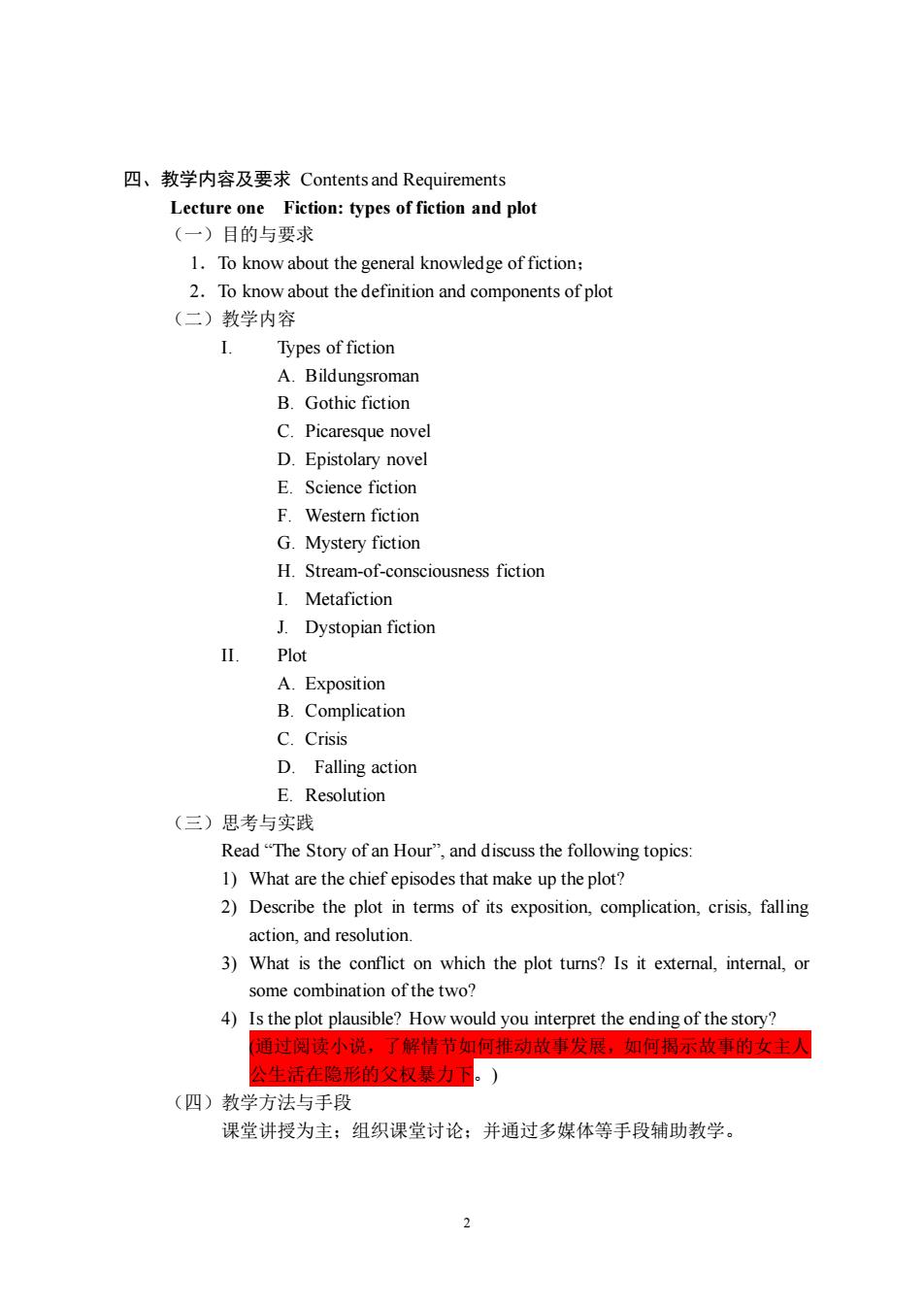
四、教学内容及要求Contentsand Requirements Lecture one Fiction:types of fiction and plot (一)目的与要求 1.To know about the general knowledge of fiction: 2.To know about the definition and components of plot (二)教学内容 Types of fiction A.Bildungsroman B.Gothic fiction C.Picaresque novel D.Epistolary novel E.Science fiction F.Western fiction G.Mystery fiction H.Stream-of-consciousness fictior I Metafiction J.Dystopian fiction 1 Plot A.Exposition B.Complication C.Crisis D.Falling action E.Resolution (三)思考与实践 Read"The Story of an Hour".and discuss the following topics 1)What are the chief episodes that make up the plot? 2)Describe the plot in terms of its exposition,complication,crisis,falling action,and resolution 3)What is the conflict on which the plot turns?Is it external,internal,or some combination of the two? 4)Is the plot plausible?How would you interpret the ending of the story? 通过读小说,了解情节如动故事发展,如何揭示放事的女主人 公生活在览形的义权共力。) (四)教学方法与手段 课堂讲授为主:组织课堂讨论:并通过多媒体等手段辅助教学
2 四、教学内容及要求 Contents and Requirements Lecture one Fiction: types of fiction and plot (一)目的与要求 1.To know about the general knowledge of fiction; 2.To know about the definition and components of plot (二)教学内容 I. Types of fiction A. Bildungsroman B. Gothic fiction C. Picaresque novel D. Epistolary novel E. Science fiction F. Western fiction G. Mystery fiction H. Stream-of-consciousness fiction I. Metafiction J. Dystopian fiction II. Plot A. Exposition B. Complication C. Crisis D. Falling action E. Resolution (三)思考与实践 Read “The Story of an Hour”, and discuss the following topics: 1) What are the chief episodes that make up the plot? 2) Describe the plot in terms of its exposition, complication, crisis, falling action, and resolution. 3) What is the conflict on which the plot turns? Is it external, internal, or some combination of the two? 4) Is the plot plausible? How would you interpret the ending of the story? (通过阅读小说,了解情节如何推动故事发展,如何揭示故事的女主人 公生活在隐形的父权暴力下。) (四)教学方法与手段 课堂讲授为主;组织课堂讨论;并通过多媒体等手段辅助教学
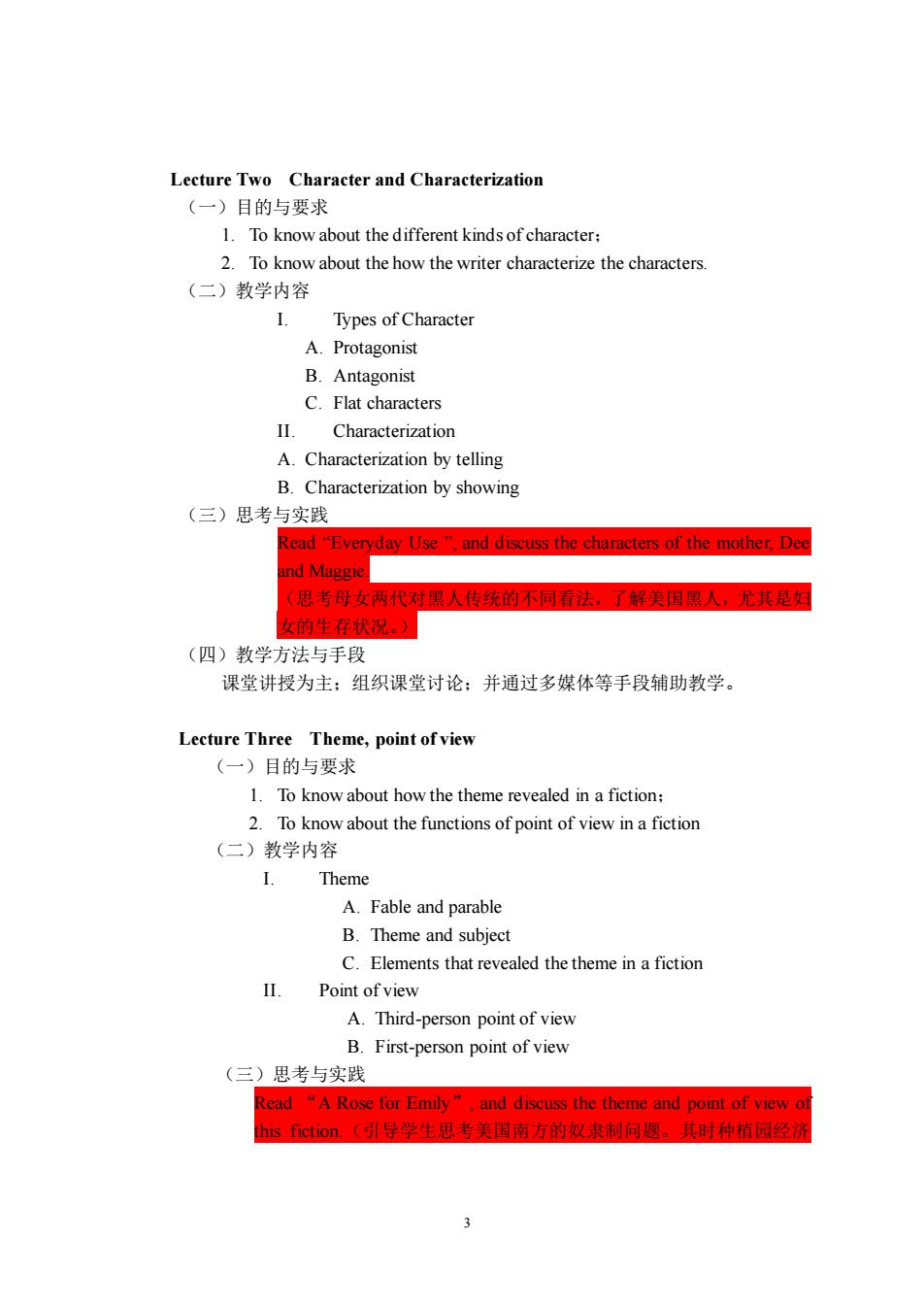
Lecture Two Character and Characterization (一)目的与要求 1.To know about the different kinds of character: 2.To know about the how the writer characterize the characters. (二)教学内容 Types of Character a Protagonist B.Antagonist C.Flat characters Characterization A.Characterization by telling B.Characterization by showing (三)思考与实践 Read Everyday Use"and discuss the characters of the mother.Dee nd Magg 思考母女两代对黑人传统的不同看法,了解关国黑人,尤其是妇 的生在 (四)教学方法与手段 课堂讲授为主:组织课堂讨论并通过多媒体等手段辅助教学。 Lecture Three Theme,point of view (一)目的与要求 1.To know about how the theme revealed in a fiction 2.To know about the functions of point of view in a fiction (二)教学内容 Theme A.Fable and parable B.Theme and subject C.Elements that revealed the theme in a fiction Point of view A.Third-person point of view B.First-person point of view (三)思考与实践 Read "A Rose for Emily",and discuss the theme and point of view o hsf©on《引导学生思考美国南方的奴求制问题。其时种植园经务 3
3 Lecture Two Character and Characterization (一)目的与要求 1. To know about the different kinds of character; 2. To know about the how the writer characterize the characters. (二)教学内容 I. Types of Character A. Protagonist B. Antagonist C. Flat characters II. Characterization A. Characterization by telling B. Characterization by showing (三)思考与实践 Read “Everyday Use ”, and discuss the characters of the mother, Dee and Maggie. (思考母女两代对黑人传统的不同看法,了解美国黑人,尤其是妇 女的生存状况。) (四)教学方法与手段 课堂讲授为主;组织课堂讨论;并通过多媒体等手段辅助教学。 Lecture Three Theme, point of view (一)目的与要求 1. To know about how the theme revealed in a fiction; 2. To know about the functions of point of view in a fiction (二)教学内容 I. Theme A. Fable and parable B. Theme and subject C. Elements that revealed the theme in a fiction II. Point of view A. Third-person point of view B. First-person point of view (三)思考与实践 Read “A Rose for Emily”, and discuss the theme and point of view of this fiction.(引导学生思考美国南方的奴隶制问题。其时种植园经济
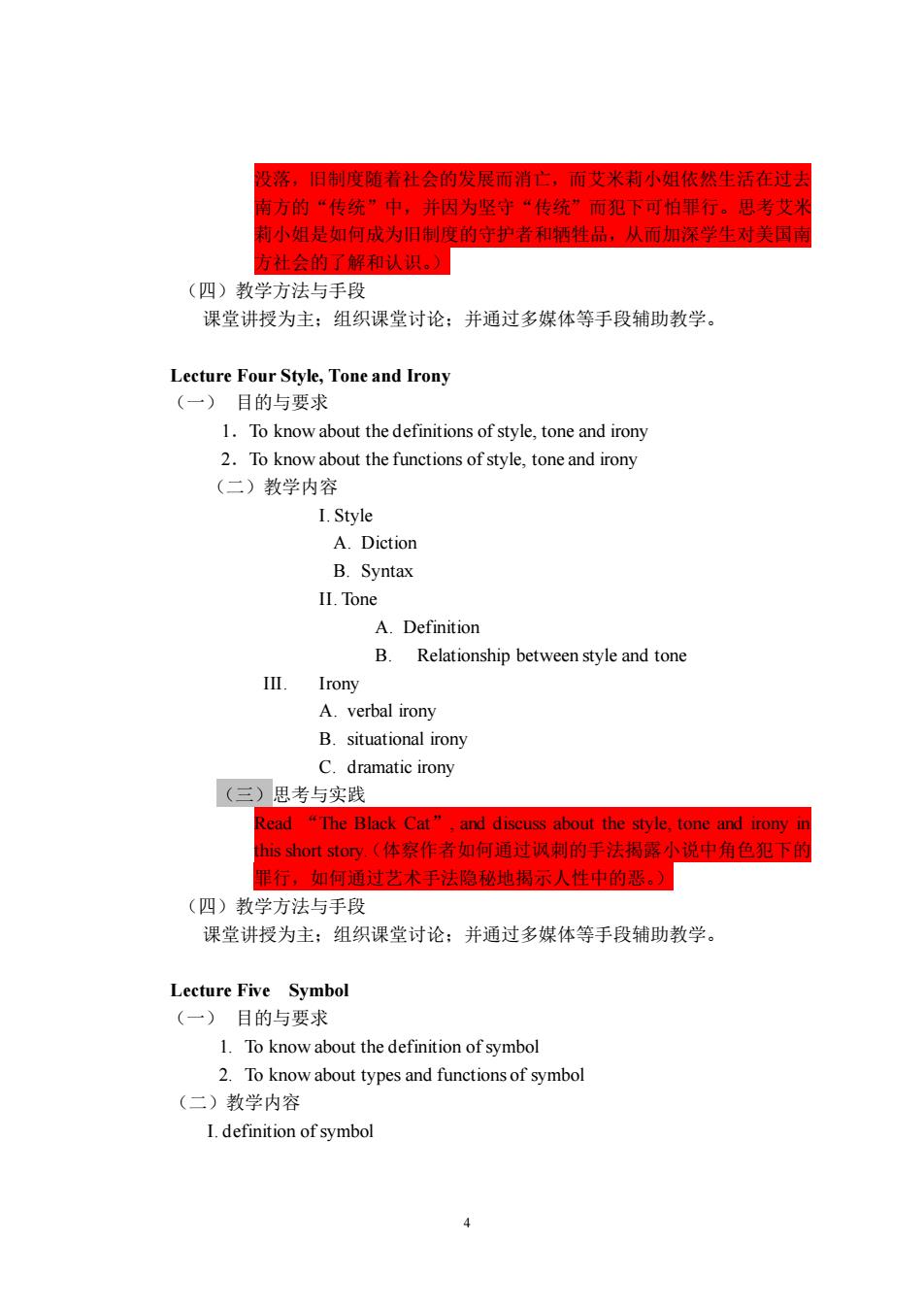
没落,阳树度随右社会的发展而消亡,而艾米莉小姐依然生活在过 南方的“传统”中,并因为坚守“传统”而犯下可怕罪行。思考 莉小姐是如何成为旧制度的守护音和牺性品,从而加深学生对美用 方社会的了解和认识。 (四)教学方法与手段 课堂讲授为主:组织课堂讨论;并通过多媒体等手段辅助教学。 Lecture Four Stvle,Tone and Ironv (一)目的与要求 1.To know about the definitions of style.tone and irony 2.To know about the functions of style,tone and irony (二)教学内容 I.Style A.Diction B.Syntax II.Tone A.Definition B.Relationship between style and tone Irony A.verbal irony B.situational irony C.dramatic irony (三)思考与实践 Read "The Black Cat"and discuss about the style,tone and irony sho5o(体察作者如何通过讽刺的手法揭露 中角色犯 推行,加何独过艺术玉法源热地福示人性中的张。 (四)教学方法与手段 课堂讲授为主:组织课堂讨论:并通过多媒体等手段辅助教学」 Lecture Five Symbol (一)目的与要求 1.To know about the definition of symbol 2.To know about types and functions of symbol (二)教学内容 I.definition of symbol
4 没落,旧制度随着社会的发展而消亡,而艾米莉小姐依然生活在过去 南方的“传统”中,并因为坚守“传统”而犯下可怕罪行。思考艾米 莉小姐是如何成为旧制度的守护者和牺牲品,从而加深学生对美国南 方社会的了解和认识。) (四)教学方法与手段 课堂讲授为主;组织课堂讨论;并通过多媒体等手段辅助教学。 Lecture Four Style, Tone and Irony (一) 目的与要求 1.To know about the definitions of style, tone and irony 2.To know about the functions of style, tone and irony (二)教学内容 I. Style A. Diction B. Syntax II. Tone A. Definition B. Relationship between style and tone III. Irony A. verbal irony B. situational irony C. dramatic irony (三)思考与实践 Read “The Black Cat”, and discuss about the style, tone and irony in this short story.(体察作者如何通过讽刺的手法揭露小说中角色犯下的 罪行,如何通过艺术手法隐秘地揭示人性中的恶。) (四)教学方法与手段 课堂讲授为主;组织课堂讨论;并通过多媒体等手段辅助教学。 Lecture Five Symbol (一) 目的与要求 1. To know about the definition of symbol 2. To know about types and functions of symbol (二)教学内容 I. definition of symbol
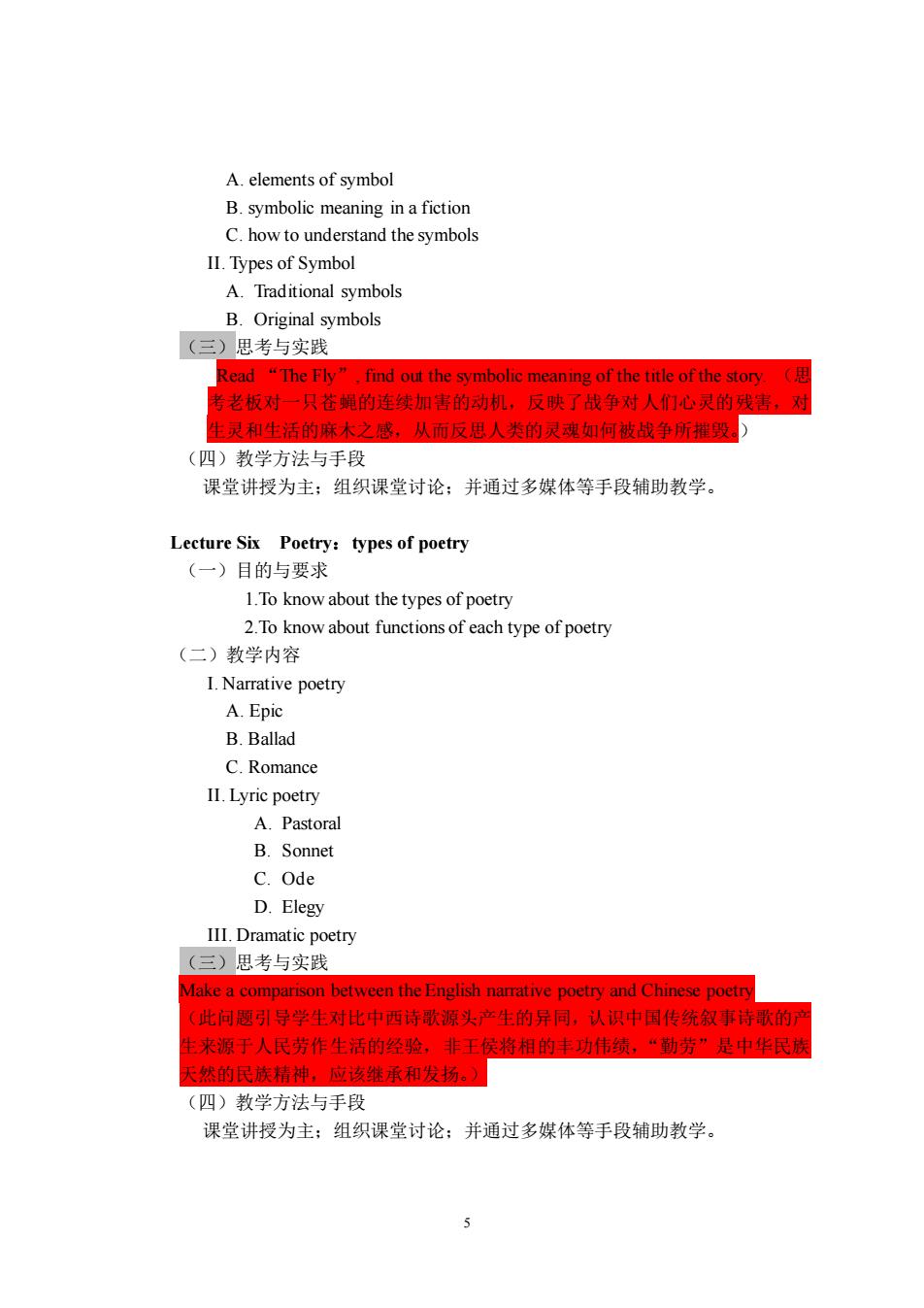
A.elements of symbol B.symbolic meaning in a fiction C.how to understand the symbols II.Types of Symbol A.Traditional symbols B.Original symbols (三)思考与实践 Read The Fly find out the symbolic meaning of the title of the story 专老板对一只苍蝇的连续加害的动机,反映了成争对人们心灵的残害 生灵利生语的麻木之感,从而反思人类的灵如何被战争所推毁 (四)教学方法与手段 课堂讲授为主;组织课堂讨论:并通过多媒体等手段辅助教学。 Lecture Six Poetry:types of poetry (一)目的与要求 1.To know about the types of poetry 2.To know about functions of each type of poetry (二)教学内容 I.Narrative poetry A.Epic B.Ballad C.Romance II.Lyric poetry A.Pastoral B.Sonnet C.Ode D.Elegy III.Dramatic poetry (三)思考与实践 Make a comparison between the English narrative poetry and Chinese poetry (此问题引导学生对比中西诗源头产生的异同,认识中国传统叙事诗散的 生来原干人民劳作生活的经哈,北工径指相的卡功伟统,“动劳”是中华民 天然的民族精神,应该继承和发扬。) (四)教学方法与手段 课堂讲授为主:组织课堂讨论:并通过多媒体等手段辅助教学。 5
5 A. elements of symbol B. symbolic meaning in a fiction C. how to understand the symbols II. Types of Symbol A. Traditional symbols B. Original symbols (三)思考与实践 Read “The Fly”, find out the symbolic meaning of the title of the story. (思 考老板对一只苍蝇的连续加害的动机,反映了战争对人们心灵的残害,对 生灵和生活的麻木之感,从而反思人类的灵魂如何被战争所摧毁。) (四)教学方法与手段 课堂讲授为主;组织课堂讨论;并通过多媒体等手段辅助教学。 Lecture Six Poetry:types of poetry (一)目的与要求 1.To know about the types of poetry 2.To know about functions of each type of poetry (二)教学内容 I. Narrative poetry A. Epic B. Ballad C. Romance II. Lyric poetry A. Pastoral B. Sonnet C. Ode D. Elegy III. Dramatic poetry (三)思考与实践 Make a comparison between the English narrative poetry and Chinese poetry (此问题引导学生对比中西诗歌源头产生的异同,认识中国传统叙事诗歌的产 生来源于人民劳作生活的经验,非王侯将相的丰功伟绩,“勤劳”是中华民族 天然的民族精神,应该继承和发扬。) (四)教学方法与手段 课堂讲授为主;组织课堂讨论;并通过多媒体等手段辅助教学
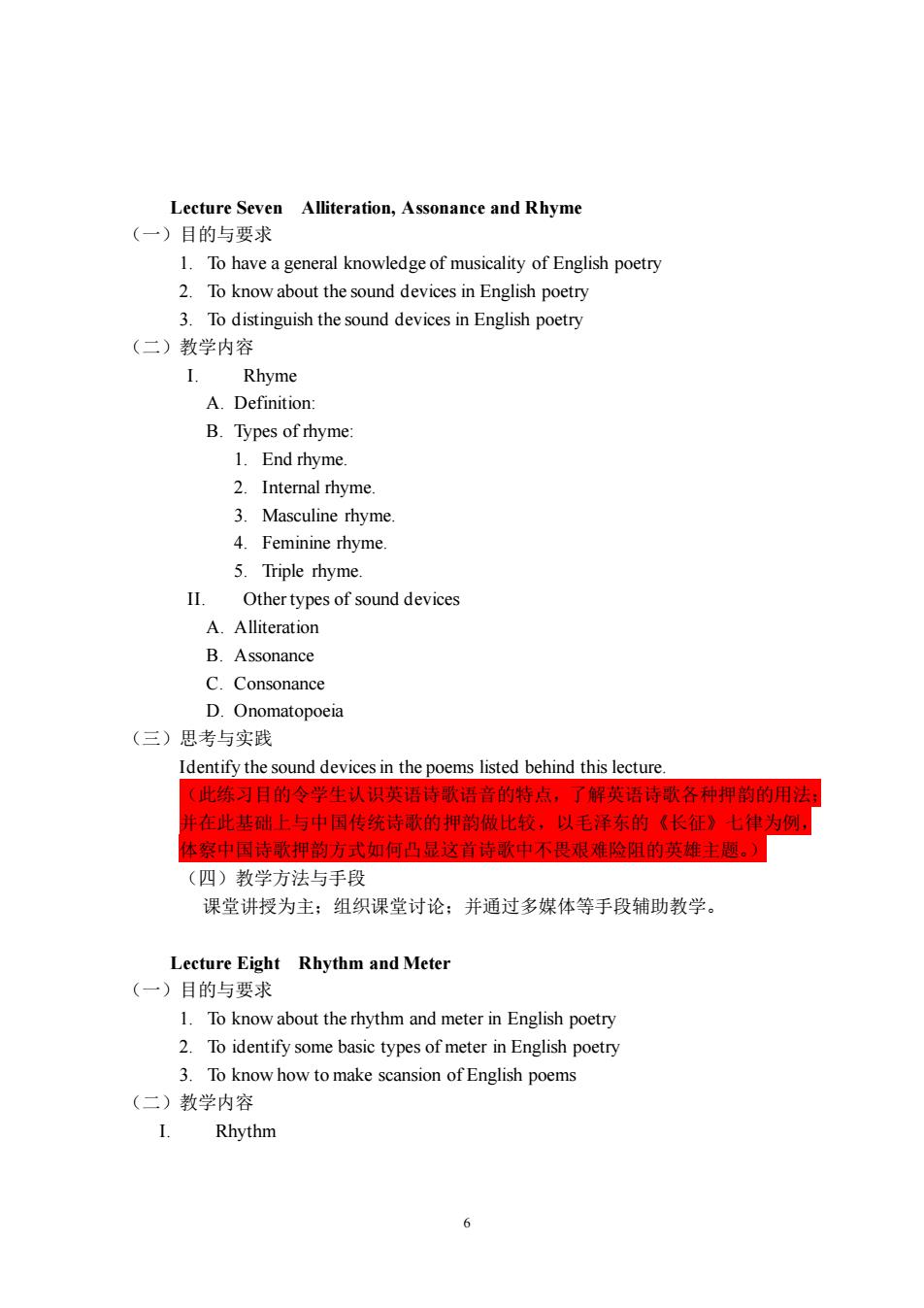
Lecture Seven Alliteration,Assonance and Rhyme (一)目的与要求 1.To have a general knowledge of musicality of English poetry 2.To know about the sound devices in English poetry 3.To distinguish the sound devices in English poetry (二)教学内容 I Rhyme A.Definition: B.Types of rhyme 1.End rhyme. 2.Internal rhyme 3.Masculine rhyme 4.Feminine rhyme 5.Triple rhyme II. Other types of sound devices B.Assonance C.Consonance D.Onomatopoeia (三)思考与实践 Identify the sound devices in the poems listed behind this lecture. (此练习目的令学生认识英语诗歌音的特点,了解英语诗歌各种韵的用 牛在此基新上与中固传统诗款的拥韵做比新,以王羊东的《长征》七律 本经中国诗押韵方式如何凸显这首诗歌中不提限难险阻的 (四)教学方法与手段 课堂讲授为主:组织课堂讨论并通过多媒体等手段辅助教学。 Lecture Eight Rhythm and Meter (一)目的与要求 1.To know about the rhythm and meter in English poetry 2.To identify some basic types of meter in English poetry 3.To know how to make scansion of English poems (二)教学内容 Rhythm 6
6 Lecture Seven Alliteration, Assonance and Rhyme (一)目的与要求 1. To have a general knowledge of musicality of English poetry 2. To know about the sound devices in English poetry 3. To distinguish the sound devices in English poetry (二)教学内容 I. Rhyme A. Definition: B. Types of rhyme: 1. End rhyme. 2. Internal rhyme. 3. Masculine rhyme. 4. Feminine rhyme. 5. Triple rhyme. II. Other types of sound devices A. Alliteration B. Assonance C. Consonance D. Onomatopoeia (三)思考与实践 Identify the sound devices in the poems listed behind this lecture. (此练习目的令学生认识英语诗歌语音的特点,了解英语诗歌各种押韵的用法; 并在此基础上与中国传统诗歌的押韵做比较,以毛泽东的《长征》七律为例, 体察中国诗歌押韵方式如何凸显这首诗歌中不畏艰难险阻的英雄主题。) (四)教学方法与手段 课堂讲授为主;组织课堂讨论;并通过多媒体等手段辅助教学。 Lecture Eight Rhythm and Meter (一)目的与要求 1. To know about the rhythm and meter in English poetry 2. To identify some basic types of meter in English poetry 3. To know how to make scansion of English poems (二)教学内容 I. Rhythm
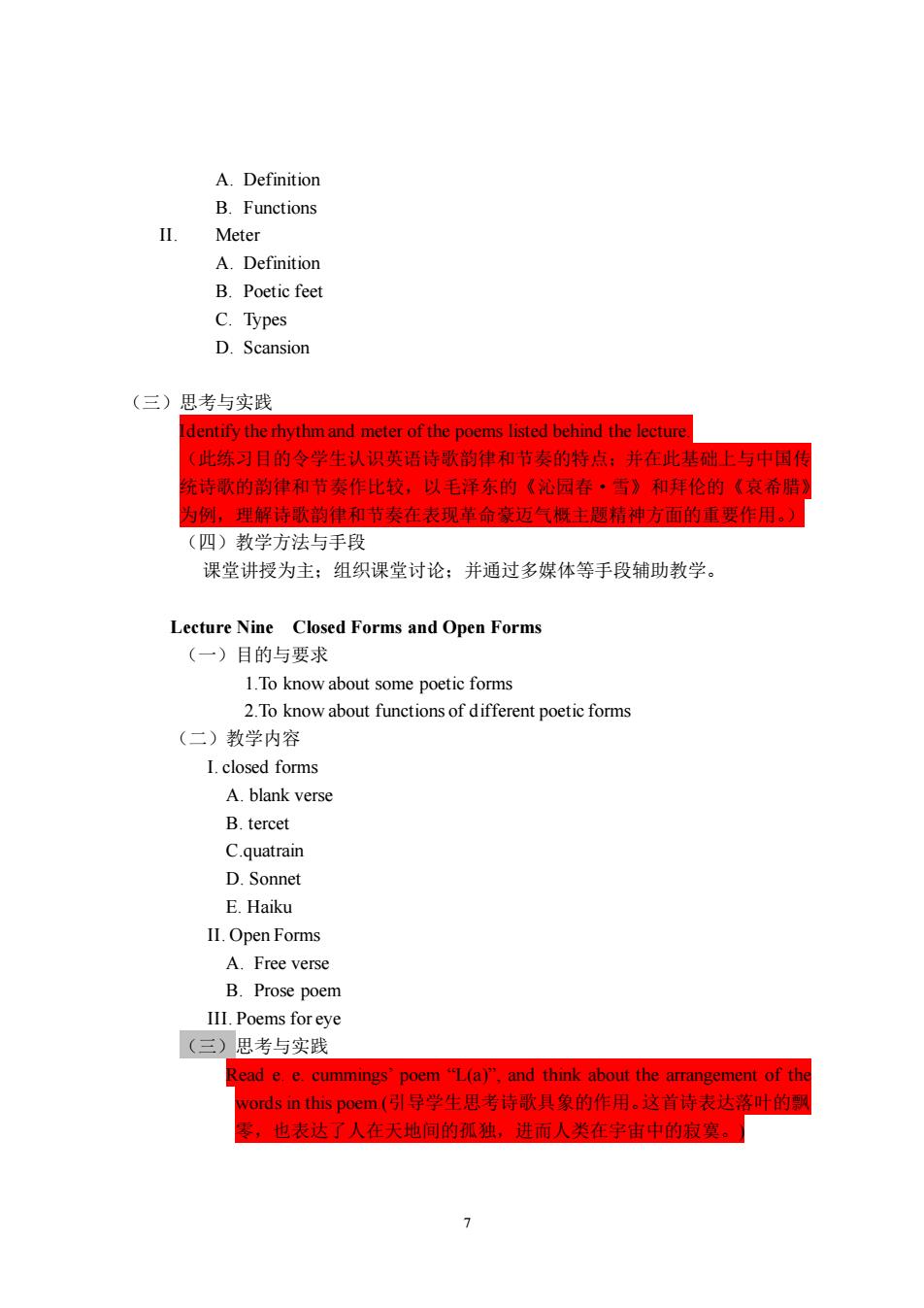
A Definition B.Functions Meter A.Definition B.Poetic feet C.Types D.Scansion (三)思考与实践 dentify the rhythm and meter of the poems listed behind the lecture (世练习的今学生认语韵和节的特点在此础上与由用 统诗歌的胸律和节奏作比较,以毛泽东的《沁园春·雪》和拜伦的《泉希鼎 为例,理解诗歌韵律和节奏在表现革命京迈气概主题精神方面的重要作用 (四)教学方法与手段 课堂讲授为主:组织课堂讨论:并通过多媒体等手段辅助教学。 Lecture Nine Closed Forms and Open Forms (一)目的与要求 1.To know about some poetic forms 2.To know about functions of different poetic forms (二)教学内容 I.closed forms A.blank verse B.tercet C.quatrain D Sonnet E.Haiku II.Open Forms A.Free verse B.Prose poem III.Poems for eye (三)思考与实践 Read e e.cummings'poem"L(a)".and think about the arrangement of th dsnh脑poem(引导学生思考诗敞具象的作用。这首诗表达落叶的 零,也表达人在大地回的孤独进而人类在空宙中的寂臣
7 A. Definition B. Functions II. Meter A. Definition B. Poetic feet C. Types D. Scansion (三)思考与实践 Identify the rhythm and meter of the poems listed behind the lecture. (此练习目的令学生认识英语诗歌韵律和节奏的特点;并在此基础上与中国传 统诗歌的韵律和节奏作比较,以毛泽东的《沁园春·雪》和拜伦的《哀希腊》 为例,理解诗歌韵律和节奏在表现革命豪迈气概主题精神方面的重要作用。) (四)教学方法与手段 课堂讲授为主;组织课堂讨论;并通过多媒体等手段辅助教学。 Lecture Nine Closed Forms and Open Forms (一)目的与要求 1.To know about some poetic forms 2.To know about functions of different poetic forms (二)教学内容 I. closed forms A. blank verse B. tercet C.quatrain D. Sonnet E. Haiku II. Open Forms A. Free verse B. Prose poem III. Poems for eye (三)思考与实践 Read e. e. cummings’ poem “L(a)”, and think about the arrangement of the words in this poem.(引导学生思考诗歌具象的作用。这首诗表达落叶的飘 零,也表达了人在天地间的孤独,进而人类在宇宙中的寂寞。)

(四)教学方法与手段 课堂讲授为主:组织课堂讨论并通过多媒体等手段辅助教学。 Lecture Ten Figures of Speech (一)目的与要求 1.To know about types of figures of speech 2.To identify the figures of speech in English poetry (二)教学内容 I.Definition of Figures of speech II.Types of figures of Speech A.Simile and metaphor B.Metonymy and Synecdoche C.Irony D.Paradox E.Personification F.Apostrophe (三)思考与实践 Read John Donne's"Death Be Not Proud"find out the figures of speech in th nd think about how the author use these rhetoncal devices to mo Death (四)教学方法与手段 课堂讲授为主:组织课堂讨论:并通过多媒体等手段辅助教学。 Lecture eleven Image and symbol (一)目的与要求 1.To know about the definition of image in poetry 2.To know about symbol used in poetry (二)教学内容 I.Image a definition B.functions C.Imagist movement II.Symbol A.Definition B.Functions
8 (四)教学方法与手段 课堂讲授为主;组织课堂讨论;并通过多媒体等手段辅助教学。 Lecture Ten Figures of Speech (一)目的与要求 1. To know about types of figures of speech 2. To identify the figures of speech in English poetry (二)教学内容 I. Definition of Figures of speech II. Types of figures of Speech A. Simile and metaphor B. Metonymy and Synecdoche C. Irony D. Paradox E. Personification F. Apostrophe (三)思考与实践 Read John Donne’s “ Death Be Not Proud”, find out the figures of speech in this poem, and think about how the author use these rhetorical devices to mock Death. (四)教学方法与手段 课堂讲授为主;组织课堂讨论;并通过多媒体等手段辅助教学。 Lecture Eleven Image and Symbol (一)目的与要求 1.To know about the definition of image in poetry 2.To know about symbol used in poetry (二)教学内容 I. Image A. definition B. functions C. Imagist movement II.Symbol A. Definition B. Functions
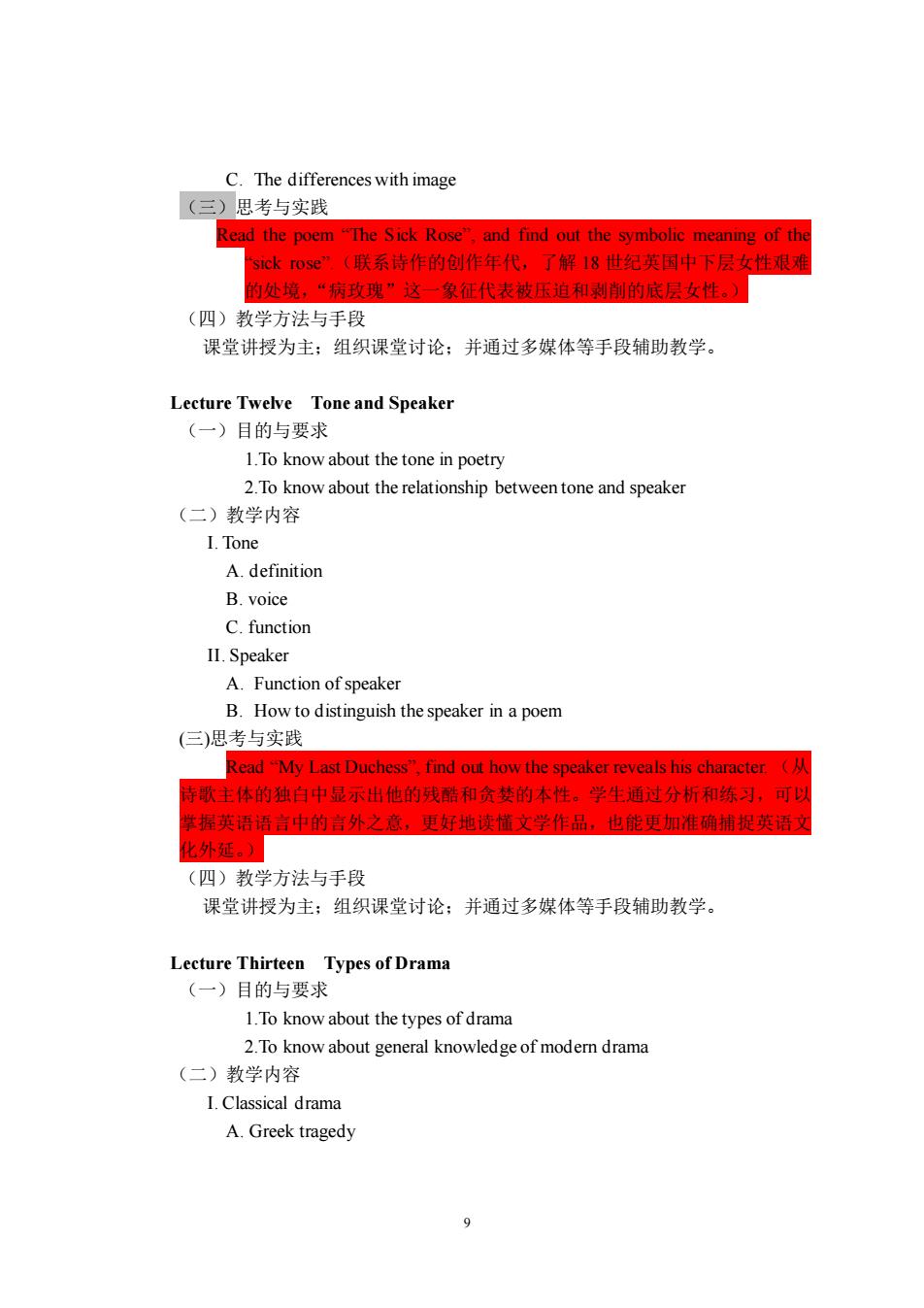
C.The differences with image (三)思考与实践 Read the poem"The Sick Rose"and find out the symbolic meaning of t C止0e”《联系诗作的创作年代了解18世纪英国中下层 的处境,“病政瑰”这一象征代表被压迫利刻削的底层女性。) (四)教学方法与手段 课堂讲授为主:组织课堂讨论:并通过多媒体等手段辅助教学。 Lecture Twelve Tone and speaker (一)目的与要求 1.To know about the tone in poetry 2.To know about the relationship between tone and speaker (二)教学内容 I.Tone A.definition B.voice C.function II.Speaker A.Function of speaker B.How to distinguish the speaker in a poem (三)思考与实践 Read My Last Duchess",find out how the speaker reveals his character. 诗主体的独自中显示出他的残酷和贪婪的本性。学生通过分析和练习,可 三隆虫语语言中的宫外之总,更地实城文学学作品,也能更如桂确铺提英诗 化外延。 (四)教学方法与手段 课堂讲授为主;组织课堂讨论;并通过多媒体等手段辅助教学 Lecture Thirteen Types of Drama (一)目的与要求 1.To know about the types of drama 2.To know about general knowledge of modern drama (二)教学内容 I.Classical drama A.Greek tragedy
9 C. The differences with image (三)思考与实践 Read the poem “The Sick Rose”, and find out the symbolic meaning of the “sick rose”.(联系诗作的创作年代,了解 18 世纪英国中下层女性艰难 的处境,“病玫瑰”这一象征代表被压迫和剥削的底层女性。) (四)教学方法与手段 课堂讲授为主;组织课堂讨论;并通过多媒体等手段辅助教学。 Lecture Twelve Tone and Speaker (一)目的与要求 1.To know about the tone in poetry 2.To know about the relationship between tone and speaker (二)教学内容 I. Tone A. definition B. voice C. function II. Speaker A. Function of speaker B. How to distinguish the speaker in a poem (三)思考与实践 Read “My Last Duchess”, find out how the speaker reveals his character. (从 诗歌主体的独白中显示出他的残酷和贪婪的本性。学生通过分析和练习,可以 掌握英语语言中的言外之意,更好地读懂文学作品,也能更加准确捕捉英语文 化外延。) (四)教学方法与手段 课堂讲授为主;组织课堂讨论;并通过多媒体等手段辅助教学。 Lecture Thirteen Types of Drama (一)目的与要求 1.To know about the types of drama 2.To know about general knowledge of modern drama (二)教学内容 I. Classical drama A. Greek tragedy
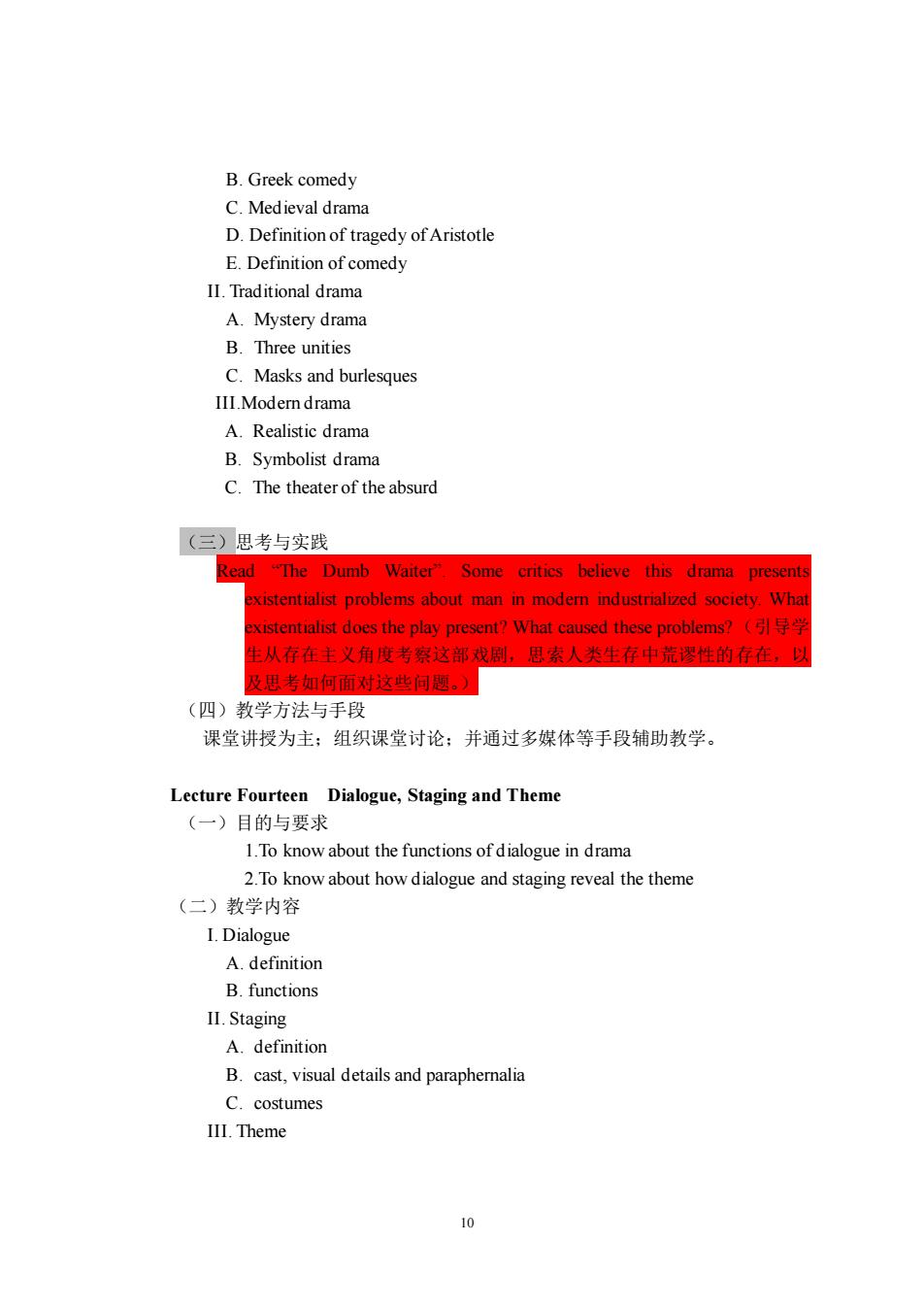
B.Greek comedy C.Medieval drama D.Definition of tragedy of Aristotle E.Definition of comedy II.Traditional drama A.Mystery drama B.Three unities C.Masks and burlesques III.Moderndrama A.Realistic drama B.Symbolist drama C.The theater of the absurd (三)思考与实践 Read The Dumb Waiter Some critics believe this drama present kistentialist problems about man in modem industrialized society Wha istentialist does the play present?What caused these problems?( 生从存在主义角度考察这部发剧,思索人类生存中荒谬性的存在, 思考如何面对这些何恩。) (四)教学方法与手段 课堂讲授为主:组织课堂讨论并通过多媒体等手段辅助教学 Lecture Fourteen Dialogue,Staging and Theme (一)目的与要求 1.To know about the functions of dialogue in drama 2.To know about how dialogue and staging reveal the theme (二)教学内容 I Dialogue A.definition B.functions II.Staging A.definition B.cast,visual details and paraphernalia C.costumes III.Theme 10
10 B. Greek comedy C. Medieval drama D. Definition of tragedy of Aristotle E. Definition of comedy II. Traditional drama A. Mystery drama B. Three unities C. Masks and burlesques III.Modern drama A. Realistic drama B. Symbolist drama C. The theater of the absurd (三)思考与实践 Read “The Dumb Waiter”. Some critics believe this drama presents existentialist problems about man in modern industrialized society. What existentialist does the play present? What caused these problems? (引导学 生从存在主义角度考察这部戏剧,思索人类生存中荒谬性的存在,以 及思考如何面对这些问题。) (四)教学方法与手段 课堂讲授为主;组织课堂讨论;并通过多媒体等手段辅助教学。 Lecture Fourteen Dialogue, Staging and Theme (一)目的与要求 1.To know about the functions of dialogue in drama 2.To know about how dialogue and staging reveal the theme (二)教学内容 I. Dialogue A. definition B. functions II. Staging A. definition B. cast, visual details and paraphernalia C. costumes III. Theme